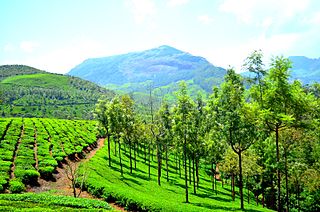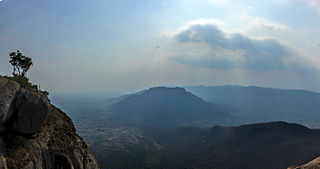
Ooty, abbreviated as Udhagai) is a town and municipality in the Nilgiris district of the Indian state of Tamil Nadu, 86 km (53 mi) north west of Coimbatore, and the headquarters of the Nilgiris district. In the Nilgiri hills, it is known as the "Queen of Hill Stations" and is a popular tourist destination.

Munnar is a town and hill station located in the Idukki district of the southwestern Indian state of Kerala. Munnar is situated at around 1,600 metres (5,200 ft) above mean sea level, in the Western Ghats mountain range. Munnar is also called the "Kashmir of South India" and is a popular honeymoon destination.

Soliga, also spelled Solega, Sholaga and Shōlaga, is an ethnic group of India. Its members inhabit the mountain ranges mostly in the Chamarajanagar district of southern Karnataka and Erode district of Tamil Nadu. Many are concentrated in the Biligiriranga Hills and associated ranges, mainly in the talukas Yelandur, Kollegal and Chamarajanagar of Karnataka. The Soliga speak Sholaga, which belongs to the Dravidian family. Under Indian law, they are recognized as a scheduled tribe, they have a population of around 40,000.

The All India Anna Dravida Munnetra Kazhagam is an Indian regional political party with great influence in the state of Tamil Nadu and the union territory of Puducherry. It is a Dravidian party founded by the former chief minister of Tamil Nadu M. G. Ramachandran (M.G.R.) at Madurai on 17 October 1972 as a breakaway faction from the Dravida Munnetra Kazhagam after M. Karunanidhi expelled him from the party for demanding an account as the party treasurer. The party is adhering to the policy of socialism and secularism based on the principles of C. N. Annadurai (Anna) collectively coined as Annaism by M.G.R. The party has won a seven-time majority in the Tamil Nadu Legislative Assembly and has emerged as the most successful political outfit in the state's history. It is currently the main opposition party in the Tamil Nadu Legislative Assembly.

The Nilgiris district is one of the 38 districts in the southern Indian state of Tamil Nadu. Nilgiri is the name given to a range of mountains spread across the borders among the states of Tamil Nadu, Karnataka and Kerala. The Nilgiri Hills are part of a larger mountain chain known as the Western Ghats. Their highest point is the mountain of Doddabetta, height 2,637 m. The district is contained mainly within the Nilgiri Mountains range. The administrative headquarters is located at Ooty. The district is bounded by Coimbatore to the south, Erode to the east, and Chamarajnagar district of Karnataka and Wayanad district of Kerala to the north. As it is located at the junction of three states, namely, Tamil Nadu, Kerala, and Karnataka, significant Malayali and Kannadiga populations reside in the district. Nilgiris district is known for natural mines of Gold, which is also seen in the other parts of Nilgiri Biosphere Reserve extended in the neighbouring states of Karnataka and Kerala too.

Alluri Sitarama Raju was an Indian revolutionary who waged an armed rebellion against the British colonial rule in India. Born in present-day Andhra Pradesh, he was involved in opposing the British in response to the 1882 Madras Forest Act that effectively restricted the free movement of adivasis in their forest habitats and prevented them from practicing their traditional form of agriculture called 'podu', which threatened their very way of life. Rise in discontent towards the British colonial rule in the backdrop of the non-cooperation movement (1920–1922) led to the Rampa rebellion (1922–1924) in which Alluri Sitarama Raju played the major role as its leader. Mustering combined forces of tribals and other sympathizers to the cause, he engaged in guerilla campaigns against the British forces across the border regions of present-day Andhra Pradesh and Odisha states in India. He was given the title "Manyam Veerudu" by the local people for his exploits.
Tiruvallur district, also spelled as Thiruvallur district, is one of the 38 districts in the Indian state of Tamil Nadu. The fast developing city of Tiruvallur is the district headquarters. The district has a mixture of urban and rural characteristics. The eastern part of Tiruvallur district is dominated by urban characteristics while the Northern part of the district has influence of Andhra culture due to its position. In 2011, the district had a population of 3,728,104 with a sex-ratio of 987 females for every 1,000 males.

The Javadhu Hills are an extension of the Eastern Ghats spread across parts of Tirupattur and Tiruvannamalai districts in the northern part of the state of Tamil Nadu in south-eastern India. The hills separate Tirupattur and Tiruvannamalai districts: Tirupattur district, with its towns of Tirupattur, Vaniyambadi and Ambur, lie on the north-western side; and Tiruvannamalai district with the towns of Chengam and Polur are located on the south-eastern side.

Manjampatti Valley is a 110.9 km2 (42.8 sq mi) protected area in the eastern end of Indira Gandhi Wildlife Sanctuary and National Park (IGWS&NP) in Tirupur District, Tamil Nadu, South India. It is a pristine drainage basin of shola and montane rainforest with high biodiversity recently threatened by illegal land clearing and cultivation.
A reserved forest and protected forest in India are forests accorded a certain degree of protection. The concept was introduced in the Indian Forest Act of 1927 during the British Raj to refer to forests granted protection under the British crown in British India, but not associated suzerainties. After Indian independence, the Government of India retained the status of the reserved and protected forests, and extended protection to other forests. Many forests that came under the jurisdiction of the Government of India during the political integration of India were initially granted such protection.

The Prevention of Insults to National Honour Act, 1971 is an Act of the Parliament of India which prohibits the desecration of or insult to the country's national symbols, including the national flag, national emblem, national anthem, national motto, the constitution, and the map of India including contempt of Indian constitution.

The National Tiger Conservation Authority (NTCA) was established in India in December 2005, following a recommendation of the Tiger Task Force. The Prime Minister of India established it to reorganise the management of Project Tiger and many Tiger Reserves in India.

The Code of Criminal Procedure commonly called Criminal Procedure Code (CrPC) was the main legislation on procedure for administration of substantive criminal law in India. It was enacted in 1973 and came into force on 1 April 1974. It provides the machinery for the investigation of crime, apprehension of suspected criminals, collection of evidence, determination of guilt or innocence of the accused person and the determination of punishment of the guilty. It also deals with public nuisance, prevention of offences and maintenance of wife, child and parents.

Sathyamangalam Tiger Reserve is a protected area and tiger reserve located along the area straddling both the Western Ghats and Eastern Ghats in the Erode District of the Indian state of Tamil Nadu. The Sathyamangalam Forest Division is part of the Bramhagiri-Nilgiris-Eastern Ghats Elephant Reserve notified in 2003. In 2008, part of the Sathyamangalam Forest Division was declared a wildlife sanctuary and enlarged in 2011, it covers a forest area of 1,411.6 km2 (545.0 sq mi). It is the largest wildlife sanctuary in Tamil Nadu. In 2013, an area of 1,408.6 km2 (543.9 sq mi) of the erstwhile sanctuary was notified as a tiger reserve. It was the fourth tiger reserve established in Tamil Nadu as a part of Project Tiger and is the third largest in the state.

The Madras Forest Department, now officially, Tamil Nadu Forest Department, is a government department of Tamil Nadu. The department is responsible for managing all the protected areas and forests plus environmental and wildlife related issues of Tamil Nadu state in South India. The objective of the Tamil Nadu Forest Department is to conserve biodiversity and eco-systems of forests and wilderness areas to ensure water security and food security of the state.
The Vachathi case involved a mass crime that occurred on 20 June 1992 in the village of Vachathi, in Dharmapuri district, Tamil Nadu. A team of 155 forest personnel, 108 policemen and six revenue officials entered the Tribal-dominated Vachathi village, searching for smuggled sandalwood and to gather information about Veerappan. Under the pretext of conducting a search, the team ransacked the villagers' property, destroyed their houses, killed their cattle, assaulted around 100 villagers, and raped 18 women.

This is a list of Tamil Nadu Government laws and rules.
The Rampa Rebellion of 1922, also known as the Manyam Rebellion, was a tribal uprising led by Alluri Sitarama Raju in Godavari Agency of Madras Presidency, British India. It began in August 1922 and lasted until the capture and killing of Raju in May 1924.
Podu is a traditional system of cultivation used by tribes in India, whereby different areas of jungle forest are cleared by burning each year to provide land for crops. The word comes from the Telugu language.
The Vellaloor massacre refers to the killing of nearly 5000 people of the Kallan clan at the Vellalore village near Melur Taluk in what is now the Madurai District in the Indian state of Tamil Nadu. The massacre was ordered by Captain Rumley of the East India Company. The murder of the Indigenous people occurred, as they refused to pay taxes to the East India Company. The carnage is recorded in the 1767 annual gazette of the Madras Government.











